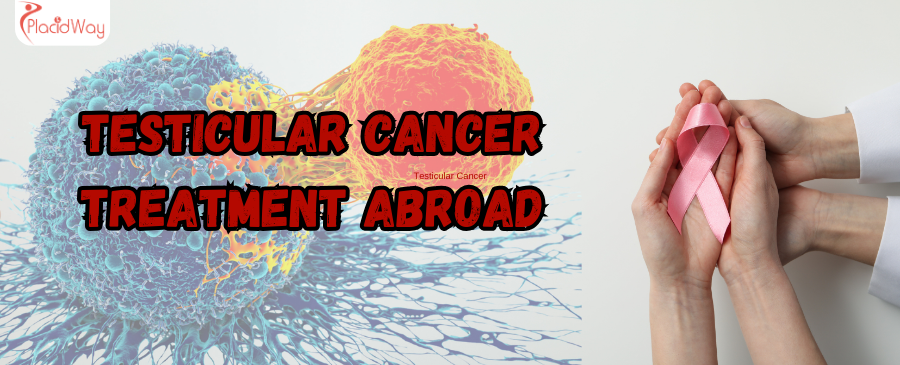
Navigating Testicular Cancer: Your Guide to Treatment, Recovery, and Global Options
Receiving a diagnosis of testicular cancer can be a deeply unsettling experience, often bringing with it a whirlwind of questions and anxieties. This type of cancer primarily affects men, most commonly between the ages of 15 and 49, making it a significant health concern for a demographic in the prime of their lives. While the initial news can be daunting, it's crucial to remember that testicular cancer is one of the most curable cancers, especially when caught early. Understanding the signs, knowing the causes, and exploring modern treatment pathways are your first steps toward effective management and recovery.
Many men search for "early signs of testicular cancer," "what causes testicular cancer," or "best treatment for testicular cancer" to educate themselves. This comprehensive guide aims to address these concerns and more, offering a clear, empathetic overview of everything you need to know. We’ll delve into the various treatment approaches, discuss what recovery looks like, and crucially, explore the growing option of seeking high-quality, affordable care through medical tourism. Whether you're just starting your research or actively seeking treatment options, this resource is designed to empower you with knowledge and support, guiding you through each stage of your journey.
From understanding the initial symptoms like a painless lump or swelling in a testicle, to the advanced medical procedures available, we’ll break down complex information into understandable insights. We know you might be wondering, "can testicular cancer be cured?" or "what are the side effects of testicular cancer treatment?" Rest assured, the medical advancements in this field are significant, offering excellent prognoses for most patients. Let's embark on this journey together, exploring hope, healing, and the many paths to recovery.
What are the Early Symptoms and Signs of Testicular Cancer?
Recognizing the early signs of testicular cancer is paramount for prompt diagnosis and successful treatment. Unlike many cancers that present vague symptoms, testicular cancer often has distinct, noticeable indicators. The most common symptom, and one that should always prompt a visit to a doctor, is a painless lump or swelling in one of the testicles. This lump can vary in size, from a pea to a grape, and might be felt during a self-examination.
Beyond a lump, other symptoms can include:
- A feeling of heaviness in the scrotum.
- A dull ache or pain in the abdomen or groin area.
- Sudden collection of fluid in the scrotum.
- Pain or discomfort in a testicle or the scrotum.
- Enlargement or tenderness of the breasts (a less common symptom, due to hormones produced by some tumors).
- Back pain (if the cancer has spread to lymph nodes behind the abdomen).
It's important to note that many of these symptoms can also be caused by non-cancerous conditions. For example, an infection, injury, or benign cyst can cause similar discomfort or swelling. This is why a professional medical evaluation is crucial. Regular self-examinations are an excellent habit for men, helping them become familiar with what's normal for their body, making any changes easier to detect.
What Causes Testicular Cancer and Who is at Risk?
While the precise "cause" of testicular cancer isn't fully understood, researchers have identified several key risk factors that increase a man's likelihood of developing the disease. It's crucial to remember that having a risk factor doesn't guarantee you'll get cancer, and many men who develop testicular cancer have none of the known risk factors.
Primary risk factors include:
- Cryptorchidism (Undescended Testicle): This is the strongest risk factor. If one or both testicles don't move down into the scrotum before birth, the risk is significantly higher, even if surgically corrected later.
- Family History: Having a father or brother who had testicular cancer increases your risk.
- Previous Testicular Cancer: Men who have had cancer in one testicle are at a higher risk of developing it in the other.
- Race and Ethnicity: White men have a higher risk than Black, Asian, or Hispanic/Latino men.
- Age: Most cases occur between ages 15 and 49, with a peak incidence around age 30-34.
- Klinefelter Syndrome: This genetic condition increases the risk.
- HIV Infection: Some studies suggest a higher risk for men with HIV.
Unlike some cancers, lifestyle factors like diet, exercise, or smoking have not been clearly linked to testicular cancer. The prevailing theory suggests that the cancer originates from germ cells (cells that make sperm) that didn't develop normally, often during fetal development. Understanding these risk factors can help individuals and their doctors maintain vigilance, especially for those in higher-risk categories.
How is Testicular Cancer Diagnosed and What Treatment Options Are Available?
Diagnosing testicular cancer typically begins with a physical examination by a doctor, who will feel the testicles for lumps, swelling, or tenderness. If a lump is found, further diagnostic tests are ordered:
- Ultrasound of the Scrotum: This imaging test uses sound waves to create a picture of the testicles, distinguishing between a solid tumor (which is more likely to be cancerous) and a fluid-filled cyst.
- Blood Tests (Tumor Markers): Specific substances in the blood, such as Alpha-fetoprotein (AFP), Human Chorionic Gonadotropin (hCG), and Lactate Dehydrogenase (LDH), can be elevated in men with testicular cancer. These markers help in diagnosis and monitoring.
- Inguinal Orchiectomy: If cancer is strongly suspected, the affected testicle is surgically removed through an incision in the groin (not the scrotum) for biopsy. This is the definitive diagnostic step and often the first line of treatment.
Once diagnosed and staged, treatment plans are tailored to the individual. The main treatment options include:
1. Surgery (Radical Inguinal Orchiectomy): This is almost always the first step. The entire testicle, along with its spermatic cord, is removed. Often, a prosthetic testicle can be implanted at the same time for cosmetic reasons. For men whose cancer has spread, lymph node dissection (RPLND) might also be performed.
2. Radiation Therapy: High-energy rays are used to kill cancer cells or keep them from growing. It’s primarily used for seminoma, a type of testicular cancer, especially when there's a risk of spread to nearby lymph nodes.
3. Chemotherapy: Drugs are used to kill cancer cells, either by stopping them from growing or by preventing them from multiplying. Chemotherapy can be given intravenously (IV) and is used for advanced testicular cancer or when cancer has recurred. Regimens like BEP (Bleomycin, Etoposide, Cisplatin) are common.
4. Surveillance: For very early-stage cancers, some patients may opt for active surveillance after surgery, meaning regular check-ups, blood tests, and imaging scans, rather than immediate additional treatment. This avoids potential side effects of chemotherapy or radiation while still monitoring for recurrence.
The choice of treatment depends on the type of testicular cancer (seminoma or non-seminoma), the stage (how far it has spread), and the patient's overall health and preferences. Most cases are highly curable, with over 95% survival rates for early-stage disease.
Who is an Eligible Candidate for Testicular Cancer Treatment?
Essentially, any male diagnosed with testicular cancer is a candidate for treatment, as intervention is crucial for a positive outcome. However, the specific type and intensity of treatment depend on several factors, making some individuals more eligible for certain approaches than others. Eligibility is generally assessed based on:
- Confirmed Diagnosis: The first step is a definitive diagnosis of testicular cancer, typically through an orchiectomy and pathological examination of the removed tissue.
- Cancer Type and Stage: Is it seminoma or non-seminoma? Has it spread to lymph nodes or other parts of the body (metastasis)? Stage I, II, or III? This dictates whether surveillance, chemotherapy, radiation, or further surgery is needed.
- Overall Health and Medical History: Patients need to be healthy enough to undergo surgery, withstand chemotherapy (which can be hard on the body), or tolerate radiation. Pre-existing heart conditions, kidney issues, or other serious health problems can influence treatment choices.
- Kidney and Lung Function: Specific chemotherapy drugs, like cisplatin and bleomycin, can impact kidney and lung function, respectively. Tests are conducted to ensure patients can safely receive these medications.
- Patient Preferences: While doctors provide expert recommendations, patient preferences regarding side effects, fertility preservation (if applicable), and lifestyle considerations are also taken into account.
For instance, a patient with very early-stage seminoma might be eligible for active surveillance, while someone with advanced non-seminoma might require aggressive chemotherapy and potentially further surgery. Fertility preservation discussions are common, especially for younger patients, as treatments like chemotherapy can affect sperm production.
What Does Recovery from Testicular Cancer Treatment Involve?
Recovery from testicular cancer treatment is a journey that varies greatly depending on the specific treatments received. It's not a single endpoint but a process of physical and emotional healing, often involving long-term follow-up.
Post-Surgery (Orchiectomy) Recovery:
- Immediate Post-Op: Patients typically stay in the hospital for 1-2 days. Pain management is provided.
- First Few Weeks: Incision care is important. Swelling and bruising are common but gradually subside. Most men can return to light activities within a week and resume normal routines, including work, within 2-4 weeks. Strenuous activities or heavy lifting are usually restricted for longer.
- Long-Term: Many men choose a testicular prosthesis for cosmetic reasons, which can be done during the initial surgery or later. Loss of one testicle typically does not affect fertility or testosterone levels as the remaining testicle usually compensates.
Post-Chemotherapy Recovery:
- During Treatment: Chemotherapy can cause significant side effects like fatigue, nausea, vomiting, hair loss, mouth sores, and a weakened immune system.
- Post-Treatment: The body needs time to recover from the cumulative effects. Fatigue can last for several months. Hair typically regrows, and other side effects gradually resolve. Regular blood tests monitor for recovery of blood counts and organ function.
- Long-Term: Some patients may experience long-term side effects such as nerve damage (neuropathy), hearing loss, kidney issues, or a slightly increased risk of secondary cancers.
Post-Radiation Therapy Recovery:
- During Treatment: Fatigue, skin irritation in the treated area, nausea, and changes in bowel habits are common.
- Post-Treatment: Most side effects subside within a few weeks to months.
Emotional and Psychological Recovery: Regardless of the physical treatment, dealing with a cancer diagnosis and its implications can be emotionally challenging. Support groups, counseling, and open communication with healthcare providers and loved ones are vital. Fertility concerns, body image, and anxiety about recurrence are common topics patients navigate.
Follow-Up and Surveillance: A crucial part of recovery is ongoing surveillance, which involves regular physical exams, blood tests (tumor markers), and imaging scans (CT scans, chest X-rays) for several years to monitor for any signs of recurrence. This frequent monitoring is a small price to pay for the high cure rates.
What are the Potential Risks and Side Effects of Testicular Cancer Treatment?
Like any medical intervention, treatments for testicular cancer come with potential risks and side effects. Understanding these helps patients prepare and manage expectations. The specific risks depend on the type of treatment:
Risks and Side Effects of Orchiectomy (Surgery):
- Immediate: Pain, bleeding, infection at the incision site, swelling, and bruising in the scrotum.
- Long-term: For most men, removal of one testicle doesn't significantly impact testosterone production or fertility, as the remaining testicle compensates. However, some men might experience a slight decrease in testosterone, potentially leading to fatigue or reduced libido, which can be managed with hormone replacement therapy.
Risks and Side Effects of Chemotherapy:
- Common: Nausea, vomiting, fatigue, hair loss (usually temporary), mouth sores, loss of appetite, changes in taste, diarrhea or constipation.
- Serious/Long-term:
- Myelosuppression: Low blood cell counts, leading to increased risk of infection (low white blood cells), anemia (low red blood cells), and easy bruising/bleeding (low platelets).
- Neuropathy: Nerve damage, causing numbness, tingling, or pain, especially in hands and feet. This can be long-lasting.
- Kidney Damage: Certain drugs like cisplatin can harm the kidneys.
- Lung Damage: Bleomycin can cause lung scarring (pulmonary fibrosis), which can be severe.
- Hearing Loss (Ototoxicity): Cisplatin can damage hearing.
- Cardiovascular Issues: Increased risk of heart attack or stroke years after treatment.
- Secondary Cancers: A small increased risk of developing other cancers later in life (e.g., leukemia).
- Fertility: Chemotherapy can temporarily or permanently impair sperm production. Sperm banking before treatment is often recommended.
Risks and Side Effects of Radiation Therapy:
- Common: Skin irritation (redness, itching, peeling) in the treated area, fatigue, nausea, diarrhea.
- Long-term:
- Sperm Count Reduction: Radiation to the pelvic area can affect sperm production, though it often recovers. Sperm banking is also advised here.
- Secondary Cancers: A small increased risk of other cancers in the treated area years later.
Doctors carefully weigh these risks against the benefits of treatment, explaining them thoroughly to patients. Supportive care and advancements in managing side effects have significantly improved the patient experience.
How Much Does Testicular Cancer Treatment Cost Worldwide?
The cost of testicular cancer treatment is a major concern for many patients, especially in countries with high healthcare expenses. The price can vary dramatically based on the stage of cancer, the type of treatment required, the facility's reputation, the country, and whether insurance covers the costs.
Cost Comparison for Testicular Cancer Treatment (Estimates in USD)
| Country | Radical Inguinal Orchiectomy (Surgery Only) | Chemotherapy Cycle (per cycle, typically 3-4 cycles needed) | Full Treatment Course (Surgery + Chemo/Radiation)* |
|---|---|---|---|
| United States | $15,000 - $35,000 | $10,000 - $30,000+ | $50,000 - $150,000+ |
| United Kingdom (Private) | $8,000 - $20,000 | $5,000 - $15,000 | $30,000 - $80,000 |
| Germany | $10,000 - $25,000 | $6,000 - $20,000 | $35,000 - $90,000 |
| Turkey | $3,000 - $8,000 | $2,000 - $5,000 | $10,000 - $30,000 |
| India | $2,500 - $7,000 | $1,500 - $4,000 | $8,000 - $25,000 |
| Mexico | $4,000 - $10,000 | $2,500 - $6,000 | $12,000 - $35,000 |
| Thailand | $3,500 - $9,000 | $2,000 - $5,500 | $10,000 - $32,000 |
*Note: "Full Treatment Course" costs are highly variable and depend heavily on the stage of cancer, number of chemotherapy cycles, need for radiation, and hospital stay duration. These are estimates and do not include travel, accommodation, or potential complications. Always get a personalized quote.
As illustrated, the cost differentials are significant, making medical tourism an attractive option for many seeking affordable yet high-quality care.
Why Should I Consider Testicular Cancer Treatment Abroad?
For many patients, particularly those in countries with high healthcare costs or long waiting times, looking abroad for testicular cancer treatment has become a viable and attractive option. Here are compelling reasons to consider medical tourism for this procedure:
- Cost Savings: This is often the primary driver. As seen in the table above, the cost of an orchiectomy, chemotherapy, or a full treatment course can be significantly lower (50-70% less) in popular medical tourism destinations compared to the US or Western Europe, without compromising on quality.
- Access to Immediate Care: In some healthcare systems, waiting lists for specialist consultations, diagnostics, or even surgery can be long. Traveling abroad often provides faster access to appointments and procedures, which is crucial for cancer treatment.
- World-Class Facilities and Expertise: Many international hospitals specialize in oncology and are accredited by international bodies (like JCI), featuring cutting-edge technology and highly experienced oncologists and surgeons trained in leading global institutions.
- Privacy and Anonymity: For some, undergoing treatment away from their home country offers a greater sense of privacy during a sensitive health journey.
- Comprehensive Packages: Many medical tourism providers and international hospitals offer all-inclusive packages that cover treatment, accommodation, airport transfers, and interpreter services, simplifying the logistics for patients and their families.
- Personalized Care: In some cases, international clinics may offer a more personalized, patient-centric approach with dedicated care coordinators.
Choosing to seek treatment abroad requires careful planning, but the potential benefits in terms of cost, speed, and access to specialized care can be life-changing.
Which Countries Offer the Best Value for Testicular Cancer Treatment?
When seeking high-value testicular cancer treatment abroad, several countries stand out for their blend of affordability, quality, and medical expertise. These destinations have invested heavily in their healthcare infrastructure, attracting international patients:
- India: Renowned for its JCI-accredited hospitals, highly skilled doctors (many trained in the West), and extremely competitive pricing. India offers advanced oncology treatments, including complex surgeries and chemotherapy regimens.
- Turkey: A rising star in medical tourism, Turkey boasts modern hospitals with state-of-the-art equipment and internationally recognized oncologists. Its geographical location makes it accessible for patients from Europe, Asia, and the Middle East, offering excellent value.
- Mexico: Popular for North American patients due to its proximity. Mexico has many JCI-accredited facilities in cities like Monterrey and Mexico City, providing high-quality cancer care at lower prices.
- Thailand: Known for its exceptional hospitality and advanced medical facilities, particularly in Bangkok. Thai hospitals offer a full spectrum of cancer treatments with excellent patient care services, appealing to patients seeking a holistic experience.
- South Korea: While potentially slightly higher in cost than India or Turkey, South Korea is a leader in medical innovation and technology. Its hospitals are at the forefront of cancer research and treatment, offering cutting-edge care with high success rates.
These countries not only provide cost-effective solutions but also often include comprehensive packages that facilitate the entire patient journey, from initial consultation to post-treatment follow-up.
What Should I Expect When Traveling Abroad for Testicular Cancer Treatment?
Embarking on a medical journey abroad requires careful planning, but many international hospitals and medical tourism facilitators have streamlined the process to make it as smooth as possible. Here’s what you can generally expect:
- Initial Consultation and Preparation: You’ll typically start by sending your medical records (diagnosis, pathology reports, imaging scans) to a chosen clinic or medical tourism agency. They will provide an initial assessment, treatment plan, and a detailed cost estimate.
- Travel Logistics:
- Visa: Check visa requirements for your chosen destination. Many countries offer medical visas.
- Flights: Book flights well in advance. Consider direct flights to minimize travel stress.
- Accommodation: Many hospitals have partnerships with nearby hotels or offer on-site guest facilities. Medical tourism agencies often arrange this.
- Travel Companion: It's highly recommended to travel with a family member or friend for support.
- Upon Arrival: You'll typically be met at the airport and transferred to your accommodation or directly to the hospital. A patient coordinator or international patient department will guide you through the initial processes.
- Pre-Treatment Assessments: Once at the hospital, you'll undergo new diagnostic tests, consultations with your oncology team, and pre-operative evaluations to confirm the treatment plan.
- Treatment and Recovery: This phase follows the typical recovery timeline discussed earlier. Hospitals are equipped to manage post-operative care and chemotherapy side effects.
- Follow-Up and Departure: Before returning home, your medical team will provide detailed instructions for post-treatment care, medication schedules, and follow-up appointments. They will also provide a complete medical report.
- Communication: Most international hospitals have interpreters on staff or provide translation services to ensure clear communication between you and your medical team.
It's like planning a complex trip, but with an added layer of medical care. Leveraging the services of a reputable medical tourism facilitator can significantly ease the burden of these logistics.
How Can I Ensure Safety and Quality of Testicular Cancer Treatment Abroad?
Ensuring the safety and quality of medical treatment abroad is paramount. While many international clinics offer excellent care, due diligence is key. Here’s how you can minimize risks and maximize the chances of a positive outcome:
- Choose Internationally Accredited Facilities: Look for hospitals accredited by recognized international bodies like the Joint Commission International (JCI). JCI accreditation signifies that a hospital meets rigorous international standards for patient safety and quality of care.
- Verify Doctor's Credentials and Experience: Research the treating oncologists and surgeons. Check their qualifications, board certifications, experience with testicular cancer, and patient outcomes. Many top international doctors have trained in Western countries.
- Read Patient Reviews and Testimonials: Seek out reviews from previous international patients. Websites and medical tourism facilitators often share these success stories and feedback.
- Request a Detailed Treatment Plan and Quote: Ensure you receive a comprehensive plan that outlines all procedures, medications, hospital stays, and follow-up care, along with a transparent breakdown of costs. Avoid hidden fees.
- Communicate Clearly: Ensure there are clear communication channels, including access to interpreters if needed. Understanding your diagnosis, treatment, and recovery instructions is crucial.
- Consider a Medical Tourism Facilitator: Reputable companies like PlacidWay specialize in connecting patients with vetted, high-quality international clinics. They can assist with vetting facilities, coordinating travel, and providing ongoing support.
- Get a Second Opinion: Even if you choose to go abroad, getting a second opinion from a local oncologist can provide peace of mind and help validate the proposed treatment plan.
- Understand Legal Recourse: Be aware of the legal and ethical frameworks in the country where you are receiving treatment. In case of adverse events, your options for recourse might differ from your home country.
Think of it like buying an expensive product online: you research, read reviews, compare features, and ensure there’s a reliable support system. The same meticulous approach applies to your health.
What are Patient Success Stories and Outcomes for Testicular Cancer Treatment Abroad?
Testicular cancer boasts one of the highest cure rates among all cancers, especially when detected and treated early. This high success rate extends to patients who seek treatment abroad, as many international facilities adhere to global standards of care.
Common themes in patient success stories from abroad include:
- Exceptional Cure Rates: Patients often report excellent outcomes, mirroring the high survival rates seen in Western countries. For localized testicular cancer, survival rates are over 95%. Even for advanced stages, modern treatments yield survival rates often above 80%.
- Significant Cost Savings: Numerous testimonials speak to the financial relief experienced by patients who saved tens of thousands of dollars on their treatment compared to their home countries. This allows them to allocate resources to recovery or other life needs.
- Access to Advanced Technology and Expertise: Patients frequently praise the state-of-the-art equipment and the proficiency of their international medical teams, highlighting that they received care equivalent to, or sometimes surpassing, what was available locally.
- Personalized and Compassionate Care: Many patients recount experiences of highly personalized care, where doctors and nurses were attentive, communicative, and supportive throughout their journey, from pre-treatment planning to post-operative follow-up.
- Efficient and Timely Treatment: The ability to bypass long waiting lists and receive prompt diagnosis and treatment is a recurring positive theme, crucial for cancer care where time is often of the essence.
- Holistic Support: Some patients appreciate the comprehensive support services, including interpreter services, assistance with accommodation, and cultural sensitivity provided by international patient departments.
For example, a patient from the US might share how he received successful orchiectomy and chemotherapy in Turkey for a third of the price, experiencing a smooth recovery and returning home cancer-free. Another patient from Canada might laud the speed of diagnosis and treatment in India, avoiding a several-month wait in their home country, which significantly reduced their anxiety.
These stories underscore that choosing to treat testicular cancer abroad can be a pathway to not only effective medical treatment but also a positive, empowering experience that alleviates financial burden and facilitates a rapid return to health and well-being.
Take the Next Step with PlacidWay
Ready to explore treatment options abroad? Discover top clinics, compare prices, and get a free quote tailored to your needs with PlacidWay.
Cancer Treatment Abroad, Breast Cancer, Lung Cancer










Share this listing